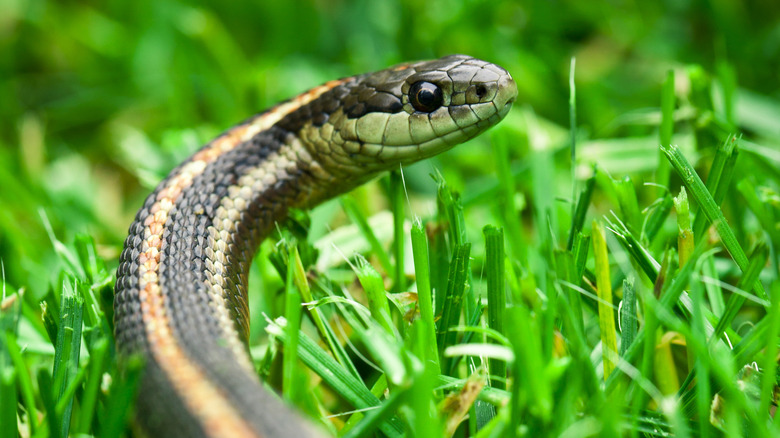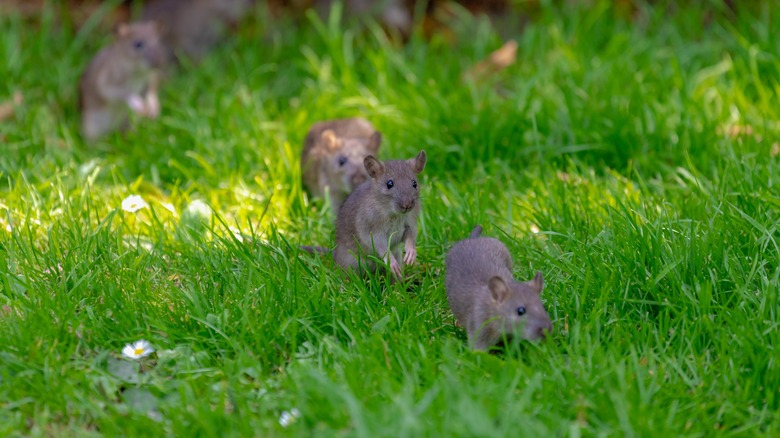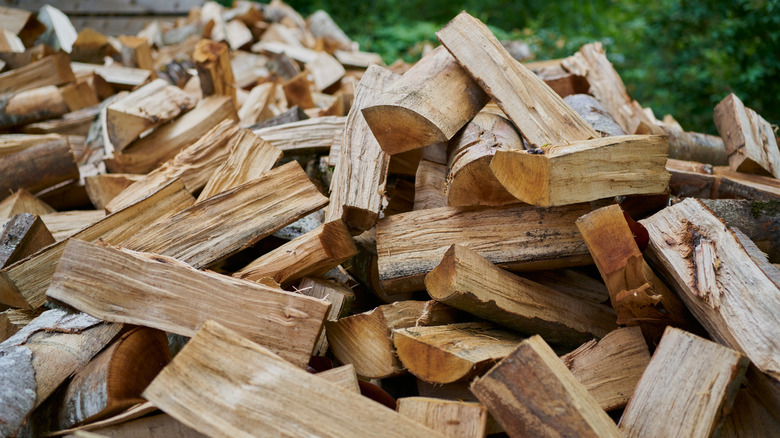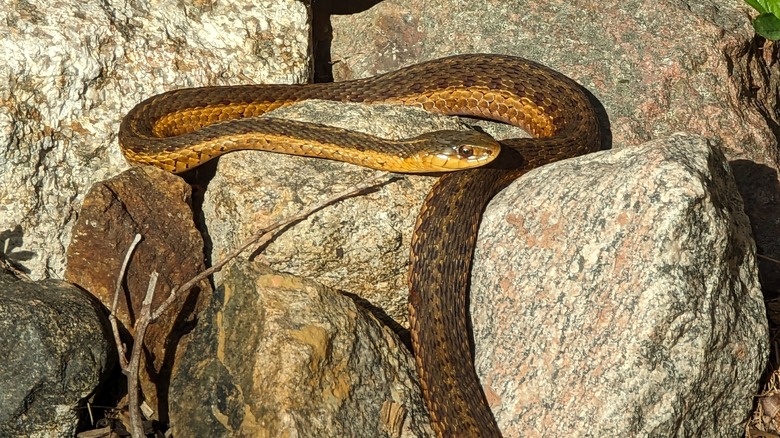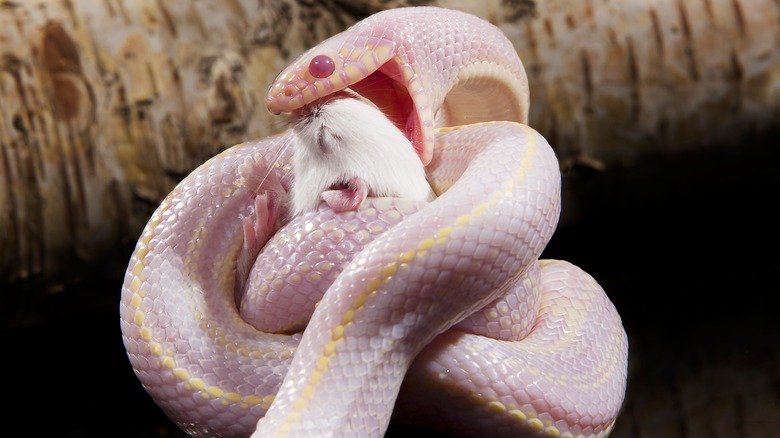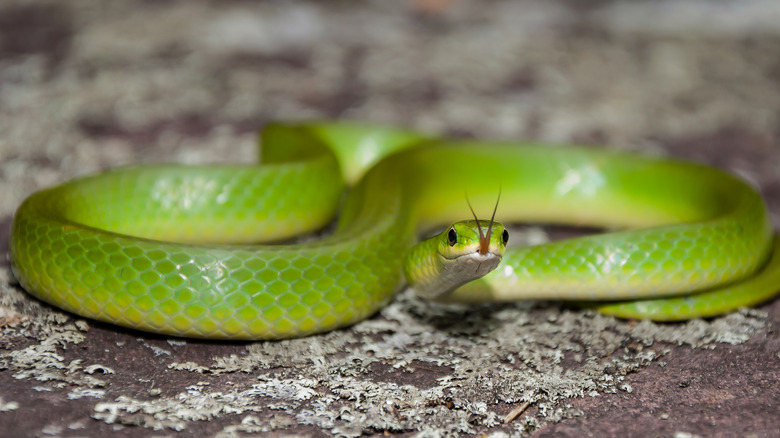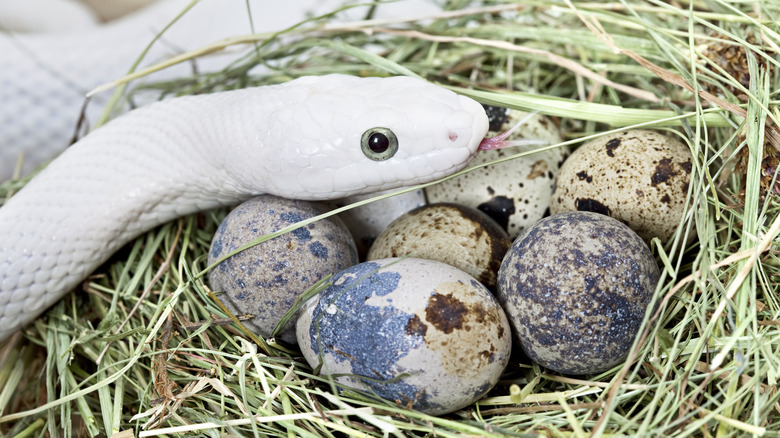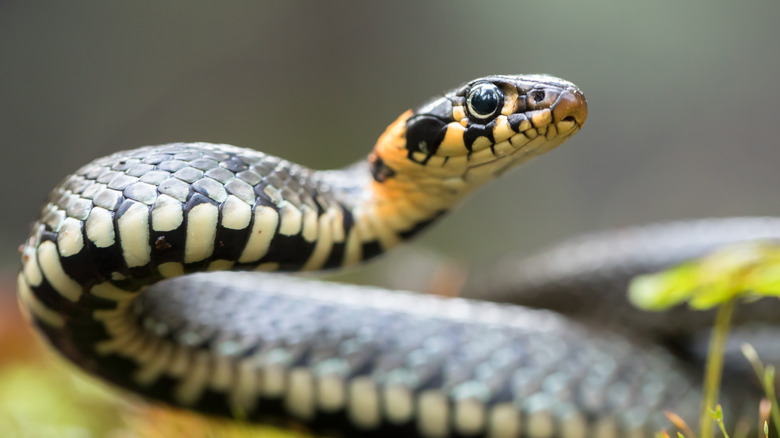9 Things That Are Attracting Snakes To Your Yard
Unless you live in Ireland, where not a single snake can be found slithering in verdant fields, you are likely going to have to deal with a fair amount of snakes using your yard as a thoroughfare. Though they are not the worst animals to find in your yard, snakes often appear on people's fears list. The question is: Why are they showing up in the first place?
To help answer this question, Jay Brewer, founder of The Reptile Zoo and host of "Reptile Royalty" on Roku TV, spoke exclusively to Outdoor Guide about what you can do to stop snakes from coming into your yard. As you'll see throughout this list, there is a case to be made for actually allowing some snake species to roam freely on your property. Still, it is worth knowing exactly what is going on in your yard that is inviting snakes and what you can do to mitigate this problem, should you choose to.
Much of what attracts a snake has to do with opportunity. Snakes won't be drawn to your yard unless it offers three things: food, sunlight, and shelter. If your yard provides all of these in abundance, you're going to be seeing some snakes. To help you understand what you might be dealing with, check out our list of snakes ranked by danger level.
Water is the main attractor
Like all other living beings, snakes need water in order to survive. While it is not as essential to their lives as it is to other animals, snakes still need to be able to hydrate themselves, albeit rarely. However, the main reason your yard's water features are attracting snakes is not their need for hydration but other creatures' need for it.
The presence of water on your property, whether it's an abutting lake, stream, pond, or backyard pool, means that there will be plenty of rodents there to drink it. Brewer says: "Snakes are attracted to the water, of course, because where there's water, there's going to be more [of a] likeliness to have rodents. So, generally speaking, most of the snakes that you're going to see in your yard are going to be rodent-eaters." These include species like rat snakes, milk snakes, and garter snakes.
While a lot does depend on whether or not you have water features on your property, rest assured that even the presence of a garden hose will attract snakes. Wherever rodents can drink, a snake is likely to be lurking in wait. Or, if the season is particularly dry, the snake might just be around to get a drink.
Your garden isn't just feeding you
There is no denying that growing a garden is a wonderful thing to do with your property. But gardening is also good for your health, as it reduces stress levels and contributes greatly to your overall physical well-being and food security. Still, you need to be aware that the fruits and vegetables you grow in your garden aren't just feeding you.
Aside from the types of insect pests that can take over a garden, rats, other rodents, and small animals will find their way into the vegetation and nibble away at your produce. Naturally, this is going to attract snakes, especially rat-eating species like the corn snake. "The reason why they call them corn snakes is because [people] find them around corn fields and corn. Because what's around corn? Rodents," says Brewer. "So anything that's going to attract rodents, anything that's going to help wildlife like small rodents and lizards survive, is going to probably attract some snakes."
The easiest thing to do to keep rodent pests, and therefore snakes, out of your yard is to use repellents. Opt for the more organic route, such as concoctions made of spices — garlic is a great way to keep pests away without resorting to potentially harmful chemicals. Cinnamon also works wonders for your garden. However, there is a good case to be made for allowing snakes to reign in your garden. But more on that later.
Your yard has so many great hiding places
There is no shortage of areas in your yard for these reptiles to create a home, and you should know the most common places snakes hide in your yard. Whether it is the winter firewood pile, the crevices of a stone wall, or nestled in the tall grass you haven't mowed in a few weeks, a snake will be able to find a place to hide and secure itself. All of these areas, and others like them, are attractive to snakes because they offer shelter from the elements and protection from predators like larger birds, cats, and people.
However, as Brewer points out, there is another reason snakes enjoy hiding in these places. "It's really anywhere that a rodent can hide is going to be a good candidate for a snake to hide. And a snake's not really hiding there as much as [it's] waiting around for a rodent to come sneaking by. A snake is really good at ambush hunting."
If a snake can stake its claim inside of a stone wall where rats have set up their nest, life for the snake is going to be so much easier because there is ample food supply. Other areas that are attractive to both rodents and snakes include crawl spaces, underneath porches, inside garages, and in leaf piles. Regular lawn and yard maintenance will go a long way towards repelling both rats and snakes.
Snakes need sun to survive
Unlike mammals, snakes are cold blooded. What this means is that they are unable to regulate their internal body temperature and, therefore, need to rely on other sources in order to increase or decrease it. This is why you will often find snakes in one of two places. They will either be hiding in a cool, dark environment as a method of primitive air conditioning or out in the open, basking in the sun.
The latter is essential to their survival. If a snake's body temperature becomes too cold, it will not be able to function properly. Its movements will become slow and it will surely die as a result. Sunlight provides snakes with the warmth they need in order to properly function. Plus, sunlight offers essential vitamins and minerals that are crucial to a snake's health.
So, if you have any areas of your yard that are particularly sunny and radiate heat, such as driveways, stone paths, and stone walls, you are more likely to see some snakes sunning themselves. Obviously, there is not much you can do about them being there, but most snakes will slither away when a human comes too near.
The smell of rodents brings snakes to the dinner table
There is a good reason why rodents keep popping up on this list. As a primary food source for a snakes, scent plays an enormous role in a snakes ability to track down rodents and other animals such as moles, voles, small birds, lizards, and even other snakes. As they have incredibly poor eyesight, snakes use a combination of exterior vibrations and scent in order to hunt. However, you don't need to worry about these instincts affecting any of your larger pets.
"A snake's not going to be attracted to, say, a coyote scent or a dog scent or a cat scent because they don't consider that a food item. Of course, unless you live in South America or Africa or Asia where [there are] giant pythons, then that might be a different case because now that's in their food items," said Brewer. So, unless you're living in one of the areas Brewer mentioned, or you have small animals like hamsters, guinea pigs, or gerbils as pets, you won't be attracting snakes directly into your home. But, if you have a sizable rodent population, snakes are going to be making their way to your yard to help lessen the numbers.
Keep your pet food indoors or well sealed
It is understandable for anyone who does not want a slobbering mess all over their floor to keep both the dog tray and dog food outside on the porch or patio. This way, all of the dog's mess ends up outside of your house, meaning you spend less time cleaning up after them. If you're not careful, however, you might end up feeding more than just your pets.
As with many other things on this list, leaving pet food outside is going to encourage rats and other rodents to make their way onto your porch and into your pet food bags. In turn, the scent of those feasting rodents is going to draw hungry snakes to your porch. You need to be careful of this, because the last thing you want is snakes making their way inside your house, regardless of the types of animals they often eat.
In order to prevent any kind of rodents from getting into your pet food, you have two options. You can either keep the food inside and make sure that you bring in the animal trays from the porch. Or, you can leave the food outside in a rodent proof container stored in an elevated area. A stainless steel bucket will be best for this, owing to the fact that rodents can very often chew through plastic, regardless of how thick it is.
Excessive insects attract smaller snakes
Rodents and other small mammals are hardly the only sources of food for a snake. There are some snakes that travel through your yard that are far too small to take on the likes of a fully grown rat, or even a sizable mouse. So, what will these smaller snakes feast on? Our resident expert, Brewer, explains.
"There are a few snakes and, depending on where you live, that actually eat insects. So most of those are found in the desert, but we have a little tiny snake called a ring snake. They eat insects, worms — stuff like that. We have blind snakes, and they actually eat termites and little ants and different things," says Brewer.
Garter snakes, green snakes, common water snakes, and eastern rat snakes are further examples of the types of snakes that will eat insects. These crawly critters tend to hide in places such as wood piles, overgrown vegetation, and compost heaps, which is also where other snake types like to hide out. What a coincidence — insert sarcastic eye roll!
Bird nests offer irresistible opportunities
Depending on their size, most snakes are not going to go after a fully grown bird. They pose far too much of a threat. Therefore, snakes have developed a more cunning way of invading a nest. A bird being away from its roost offers a snake the perfect opportunity to attack. The nest is left defenseless. By default, whatever is inside of it, eggs and chicks, are defenseless, too.
If you are one of those people who love to birdwatch and invite all manner of wonderful twittering friends into your yard, you are likely attracting snakes without necessarily realizing it. Birds and snakes are very similar in that they will settle down wherever there is plenty of food available for them to eat. So, if you have a plethora of feeders, birds will stick around to raise their families. When birds do this, the likelihood of snakes also increases as they are attracted to the scent of the potential food source.
As far as species go, rat snakes are particularly fond of bird eggs. These include that of nesting birds and those of laying birds like chickens and ducks. If you keep either on your property and are reliant on the egg income as a source of food, you will certainly want to take preventive measures to keep snakes out of your coop. Start by transforming soup cans into stunning bird feeders to protect your feathered friends.
What can you do about it?
Now that you know what might be bringing snakes into your yard, the question is: What can you do about it? Well, depending on where you stand, having snakes in your yard might actually be a net benefit. "Snakes have a very good job. They keep rodents away that mess up your house and your yard, and so it's like they're kind of just doing the natural thing of keeping the rodent population down. If you have a lot of garden and fruits and vegetables and you've got rats chewing up all your food, it ain't such a bad thing that the rats get eliminated because the snakes are harmless, the majority of them. And, of course, if you don't know what type of snake it is, it's best just to leave the snakes alone," says Brewer.
Obviously, if there are harmful snakes like rattlesnakes and other venomous species, you need to keep them away from yourself and your family. There are ways of disposing of these snakes on your own, but it might be better to leave it to a professional in this instance. Overall, though, if the snakes are doing their natural thing, there is no reason to get rid of them. As Brewer says: "It's part of the ecosystem, and in real life, they're fine, leave them alone."
To learn more about reptiles from Jay Brewer and his team, watch Season 2 of "Reptile Royalty," now streaming on The Roku Channel.
